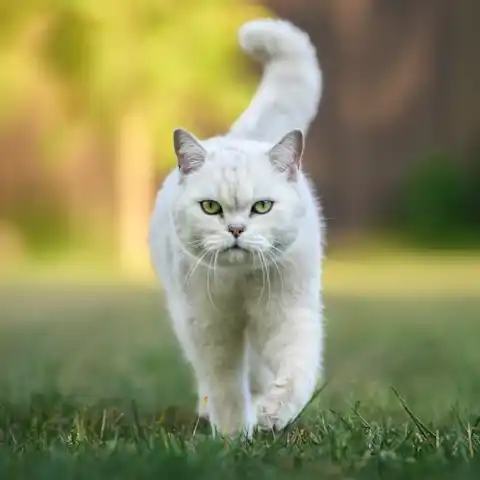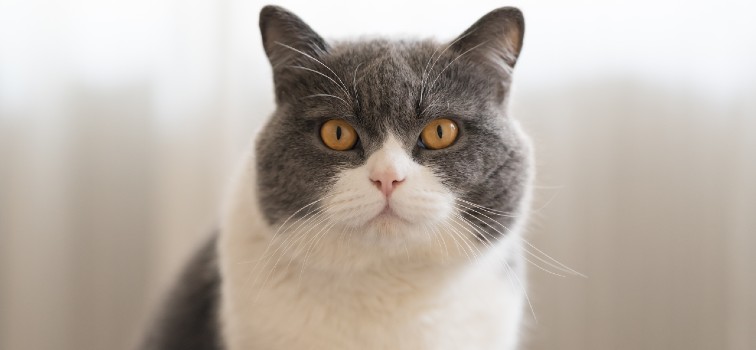British Shorthair Cat Breed Profile

Types of Cats Yes
Breed Number 40
Average Lifespan 15 to 20 years
Temperament British shorthair cats are Friendly and affectionate, loyal and devoted, good with children and other pets
Weight Males 6.8 to 8.1kg; Females 4.5 to 5.4kg
Availability Easy
Colours Available in almost every colour and coat pattern you can think of. The best known are blue and silver tabby
Grooming Once a week is adequate. A simple hand groom will often remove dead hair
British Shorthair Cat Breed Profile
The British Shorthair cat is an intelligent and calm breed. Strong and rounded, the breed comes in a variety of patterns and a grown adult can weigh between 7-17lbs.
The British Longhair - a new breed
It is not unknown for long-hair kittens to appear in litters from two short-hair parents. Until fairly recently, these were usually sold as pets, although some breeders kept a particularly nice example to use in their breeding programme when they were referred to as British Shorthair Variants, although they were unable to be shown at GCCF shows. However, some enthusiasts felt the long-hairs were worth developing in their own right.
As a consequence, a club was formed and the application made to the GCCF for recognition of the British Longhair as a new breed. At the GCCF council meeting on February 15, 2017, the name ‘British Longhair’ was officially recognised.
Since that time, British Longhairs have been shown in Assessment classes at GCCF shows and have found favour with the judges and also taken some top awards. Once the breed records show a sufficient number of Merit winners at shows, the breeders’ group will be able to apply for championship status.
At GCCF shows, British Shorthair and Longhair cats are shown in Section 3, along with Manx, Selkirk Rex, and Chartreux.

Appearance
The British Shorthair comes in a wide variety of colours and patterns. Perhaps the most popular and familiar colour is blue; but, in the self (or solid) colours, there is also white — these can have orange, blue, or odd eyes (one orange and one blue); black, chocolate, lilac, red, cream, cinnamon, and fawn.
Colour-pointed British are very popular, with the coat pattern of coloured mask and points and blue eyes, like the Siamese.
The British tipped was developed in the 1970s from the Chinchilla Persian — this lovely variety comes in both silver and gold, with green, kohl-rimmed eyes. The patched varieties of tortoiseshell, tortoiseshell and white, and bi-colour also come in a wide variety of both dominant and dilute colours.
Finally, the traditional tabby British comes in four different patterns: classic, mackerel, spotted, and ticked, and a wide variety of colours, including silver.
The appearance of the British can best be described as strong and rounded. The head is broad, the neck short and thick, and the body cobby and muscular with a broad chest and rump, strong legs, round paws, and a medium-length thick tail. The coat should be short, dense, and crisp.
Love cats? Get our free newsletter!
Personality
There is a very good reason why the British is such a popular breed with owners; it isn’t just its handsome and imposing good looks, but also its quiet intelligence and calm personality. They make great companions for children, although they are not particularly fond of being picked up and carried around. They also adapt well to apartment living.
Health
British cats are slow to mature; but, being a large, muscular cat, care must be taken to ensure they don’t become overweight as they get older and a bit lazier. They are generally a healthy breed and long-lived.
Because Persians were used as an outcross in earlier decades, PKD was an issue for the breed; but, a reliable and simple DNA test has enabled responsible breeders to eliminate this from their breeding cats.
Hypertrophic cardiomyopathy (HCM) is also known in the breed. There isn’t currently a DNA test available, but breeders can ensure that affected cats are not used in a breeding programme.
They are not high maintenance as far as grooming is concerned, but loose fur should be removed with a wide-toothed comb, especially when the cat is moulting; this will ensure that the thick coat doesn’t develop any mats, particularly in older cats who may not be as fastidious as they once were.
Males usually weigh around 9-17 lbs, and females 7-12 lbs.

History
On July 13, 1871, the first cat show in the UK was held at the Crystal Palace, London. Among the 170 exhibits present were English Shorthair cats — the forerunner of the British Shorthair. Best in Show was awarded to a 14-year-old female blue tabby Shorthair owned by Harrison Weir.
The British Shorthair traces its ancestry back to the familiar non-pedigree short-hair cat we still see in many homes today, which probably descends from European domestic cats brought into Britain by the invading Romans in the first century AD.
Harrison Weir, a natural history artist — sometimes referred to as the ‘Father of the Cat Fancy’ — drew up the first standards that cats were judged against at early shows. He particularly admired the humble street cat, and — by a programme of careful selective breeding — developed the British Shorthair into a cat of a distinct type. Harrison Weir had a profound impact on the Cat Fancy in the UK. As well as producing the first Crystal Palace show, he founded the National Cat Club (still in existence today) in 1887.
As the Cat Fancy developed at a rapid pace during the end of Queen Victoria’s reign and into the 20th century, British Shorthairs were among the most numerous exhibits at shows. The Great War had a devastating impact on the breed, but a handful of devoted breeders kept them going, and numbers at shows had recovered by the end of the 1930s.
Then came WWII and, again, a few enthusiasts managed to keep the breed alive. Because numbers were depleted after the War, breeders were obliged to outcross their British cats to maintain genetic diversity. Other breeds used were the Russian Blue, Burmese, and Chartreux. To try to restore type and boning, breeders found it necessary to use Persians. This also introduced the long-hair gene into the breed, and long-hair kittens will occasionally appear in litters, although it is possible to gene test to discover whether a cat carries long-hair or is homozygous (breeds true) for short-hair only.
Today, figures of British Shorthair cats registered by the GCCF outstrip any other breed, and their popularity as a show cat and family pet is assured.
A quarter of all kittens registered with the GCCF each year are British Shorthairs.
Remember! All breed profiles are general and every cat is an individual.
Get more advice, top tips and product reviews with our free newsletter
